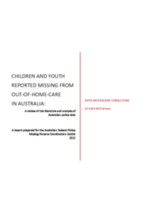In 2019, the Australian Federal Police National Missing Persons Coordination Centre (the ‘NMPCC’) contracted The Community Restorative Centre Limited and Kath McFarlane Consulting Pty Ltd to produce a report setting out a national picture of children and young people reported missing in Australia.
The aim of the project was to aid insight into the incidence of missing person reports received by police, so as to allow the NMPCC to determine and implement prevention strategies with State and Territory police to safeguard at-risk youth. Particular attention was to be directed to youth (aged 13- 17 years inclusive) in Out Of Home Care (‘OOHC’).
Australian State and Territory police services supplied de-identified data relating to 1171 individuals and 3009 episodes involving children and young people reported missing during a 30-day period in 2019.
- The project team examined this data to identify:
- The characteristics and attributes of missing youth;
- The characteristics and attributes of specific categories of missing youth, namely those who repeatedly go missing; and
- Jurisdictional similarities and differences in policy and procedures for reporting missing youth.
Following receipt of the report in 2020, the NMPCC determined to publicly release a report into children and youth (aged 0-18 years) reported missing from OOHC in Australia. Analysis of the police data is presented alongside a review of international and domestic academic and ‘grey’ literature to provide further insight into the incidence, motivations, and experiences of children and young people who go missing from OOHC, and agency responses to them.
In March 2020, almost a year after this report was commissioned, the Victorian Commission for Children and Young People announced its inquiry into young people who are absent or missing from residential care. 1 This announcement highlighted the importance of identifying the particular drivers for young people who go missing, to increase understanding of their experiences while missing, and to encourage agencies to respond effectively and appropriately when youth are located.

